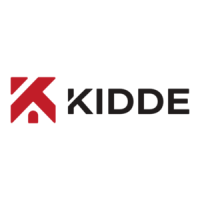Chapter 2: Front panel programming
P/N 3102351-EN • REV 005 • ISS 28DEC18 109
Table 33: Dialer programming options
Description
Set the dialer type to one of the following values.
Dual line: Uses LINE 1 and LINE 2 to transmit events to the central station
receiver and performs modem functions. In this mode, the dialer supervises and
reports faults on both lines.
Single line: Uses LINE 1 only to transmit events to the central station receiver
and performs modem functions. In this mode, the dialer supervises and reports
faults only on LINE 1.
Modem only: Dialer provides interface for outbound communications and the
ability for dial-in programming and status and report retrieval. If Modem Only is
selected, only Rings to Answer, Ring Type, and Callback Number can be
programmed. No other dialer options are displayed in the menu. The modem
function only works with LINE 1. In this mode, neither line is supervised.
None: No dialer is installed or if a dialer is installed, disables the dialer.
Secondary receiver number
Program account 1 options, and then program account 2 options. When you
have finished programming each account, choose Save.
Enter account 1 and 2’s four-digit ID code. FFFF is not valid.
Enter the primary receiver’s phone number. This can contain up to 20 digits (0-
*, #, and ,). The comma causes a two-second delay in dialing. The number or
hash symbol (#) and the asterisk symbol (*) are used with calling feature codes
and services. Consult your telephone service provider.
Enter the secondary receiver’s phone number. This can contain up to 20 digits
(0-9, *, #, and ,). The comma causes a two-second delay in dialing. The number
or hash symbol (#) and the asterisk symbol (*) are used with calling feature
codes and services. Consult your telephone service provider.
CID: Contact ID is the alarm format that the monitoring facility's Digital Alarm
Communicator Receiver (DACR) will receive. See “Default contact ID event
codes” on page 46.
Set send restorals to:
Yes: Sends off-normal event restorals to the monitoring facility DACR. Required
setting for UL/ULC installations. See “UL/ULC programming requirements” on
page 35 for details.
No: Does not send off-normal event restorals to the monitoring facility DACR
Set retry time to 1 to 45 seconds. Specifies the wait time between each time the
dialer attempts a connection to the DACR. See “UL/ULC programming
requirements” on page 35 for details.
Set the retry count to 5 to 10 attempts. Specifies how many times the dialer will
attempt to call the DACR before timing out.
Set event notification (event reporting) to:
Device: Only device information is reported or transmitted, no zone information.
This setting uses device event notification settings for reporting events. Make
sure your device event notification settings are correct. See “Central monitoring
station device programming” on page 106.

